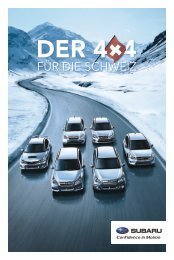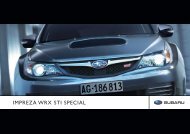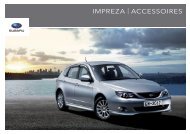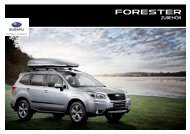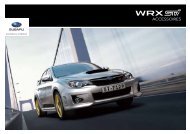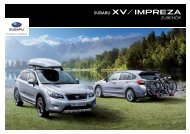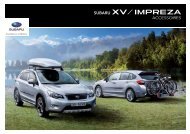Environmental & Social Report - Subaru
Environmental & Social Report - Subaru
Environmental & Social Report - Subaru
You also want an ePaper? Increase the reach of your titles
YUMPU automatically turns print PDFs into web optimized ePapers that Google loves.
1 <strong>Environmental</strong> <strong>Report</strong><br />
Development Phase/Products-Automotive Business Unit-<br />
Exhaust Emissions<br />
Substances emitted from automobiles, such as carbon monoxide (CO),<br />
hydrocarbon (HC), and nitrogen oxides (NOx), are one of the causes of air<br />
pollution in metropolitan areas where there is heavy motor traffi c. In order<br />
to improve air quality, <strong>Subaru</strong> is launching low emission vehicles (certifi ed<br />
by the Ministry of Land, Infrastructure and Transport) that meet higher<br />
standards than the regulation standards in the market one after another.<br />
Application Status of Low Emission Vehicles<br />
The 2.0L SOHC engine vehicle has reached the “ultra low emission”<br />
level for the fi rst time at <strong>Subaru</strong> by reviewing the catalyst layout in<br />
the new Legacy that has received a full model change in fi scal 2003.<br />
The “ultra low emission” level is 75% more stringent than the 2000<br />
emissions standard. Additional models, the 2.5L SOHC vehicle and<br />
the 3.0L DOHC vehicle, also meet the “ultra low emission” level. The<br />
vehicles with other engines also meet the “good low emission” level,<br />
which is 25% more stringent than the 2000 standard.<br />
The new R2 minicars that are powered by naturally aspirated<br />
engines, also satisfy the “ultra low emission” level, which is 75% more<br />
stringent than the 2000 emissions standard, while the vehicle with a<br />
supercharger meets the “excellent low emission ” level, which is 50%<br />
more stringent than the 2000 emissions standard.<br />
The new Legacy, powered by the 2.0L SOHC engine (B4, Touring<br />
Wagon) and the 3.0L DOHC engine(Touring Wagon, Outback), and the<br />
R2, powered by the naturally aspirated engine, also meet the “U-LEV”<br />
level, that is 50% more stringent than the 2005 emissions standard.<br />
Exhaust Gas Measures for the New Legacy<br />
¡ Optimized combustion chamber form with the fully improved cylinder head<br />
¡ Upgraded air-fuel ratio control performance by adopting the electronically<br />
controlled throttle valve<br />
¡ Adoption of the HC adsorbent catalyst (turbo and SOHC vehicles)<br />
Exhaust Gas Measures for the New R2 Minicar<br />
¡ Optimized combustion chamber form with the fully improved<br />
cylinder head and control of uneven combustion among the<br />
cylinders<br />
¡ Optimized combustion by adopting the Active Valve Control<br />
System (AVCS)<br />
¡ Upgraded air-fuel ratio control performance by adopting the<br />
electronically controlled throttle valve<br />
¡ Upgraded after treatment capability due to pared down walls<br />
and increased cells in the catalytic honeycomb<br />
¡ Improved air-fuel ratio control performance by adding the O2<br />
sensor to the downstream of the catalyst (adoption of the double<br />
O2 sensor system)<br />
Trends in Percentages of Low Emission Vehicles<br />
The low emission vehicles certifi cation system started in April 2000. The<br />
percentages of the <strong>Subaru</strong> brand low emission vehicles are as follows.<br />
Percentage of Low Emission Vehicles<br />
Percentage of Low Emission Vehicles<br />
Average NOx<br />
Trends in Percentages of Low Emission Vehicles on<br />
Gasoline Passenger Cars<br />
50% reduction of 2005 standard emission and<br />
75% reduction of 2000 standard emission<br />
50% reduction of 2000 standard emission<br />
(%) 25% reduction of 2000 standard emission<br />
100<br />
87 95 98<br />
80<br />
60<br />
40<br />
20<br />
0<br />
40<br />
’00 ’01 ’02 ’03<br />
Fiscal year<br />
Trends in Percentages of Low Emission Vehicles on<br />
Mini-Sized Gasoline Trucks<br />
(%) 50% reduction of 2000 standard emission<br />
100<br />
98 100<br />
80<br />
60<br />
40<br />
20<br />
0<br />
0<br />
26<br />
’00 ’01 ’02 ’03 Fiscal year<br />
Trends in NOx Averages<br />
By putting more low emission vehicles into the market, <strong>Subaru</strong> has<br />
been able to reduce the average amount of NOx emitted by <strong>Subaru</strong><br />
vehicles every year, as shown in the chart below.<br />
Trends in Average NOx Emissions of <strong>Subaru</strong> Vehicles<br />
(g/km)<br />
0.35<br />
0.30<br />
0.25<br />
0.20<br />
0.15<br />
0.10<br />
0.05<br />
0.32<br />
0.33<br />
0.28<br />
0.19<br />
0.16<br />
0.11<br />
0.06 0.05<br />
0<br />
’96 ’97 ’98 ’99 ’00 ’01 ’02 ’03 Fiscal<br />
year<br />
Notes: · The fi gures were calculated based on the regulation values and the<br />
standard values at the time of shipment.<br />
· From fi scal 2003, some of the models were calculated with the regulation<br />
values to conform to the new test mode. The new test mode is a<br />
combined mode in which the 10-15 mode and 11 mode are combined.



